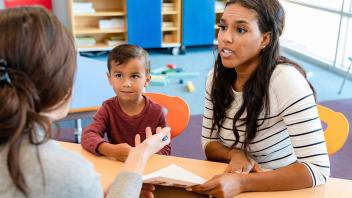Why should you read a book to an infant who doesn’t yet know the meaning of words? Why should you sing to a toddler who cannot understand your song?
Both of these activities help children make connections between words and meaning. They also help create a warm, safe environment for children and lead to a lifetime love of reading and learning.
Some parents assume that learning to read starts with memorizing the alphabet and sounding out words, but actually the fundamentals of reading begin much earlier. Adults lay the foundation for reading every day, when they point out objects to an infant, go grocery shopping with a toddler, or cook with a preschooler.
The most important thing is that teaching children about reading becomes an activity that brings children closer to the caring adults in their lives. Here are some tips for families who want to help their children make connections between meaning and words.
Infants
- Talk or sing to your baby when you change his diaper, give him a bath, feed him lunch, or join him in play.
- Introduce cardboard or cloth books with brightly colored pictures. Be aware that at this point, your baby might enjoy looking at, tossing, or chewing the books more than being read to!
- Help increase your baby’s vocabulary by asking “What’s that?” or “Where’s the teddy bear?” when looking at and enjoying books together.
- Point out words on signs at the park, at the zoo, or when walking or driving.
- As children begin to notice letters on blocks or other toys, name the letters for them. Read words aloud and explain what they mean.
Toddlers
- Reading stories before bedtime makes a good transition between active play and rest time. Toddlers may ask you to read their favorites repeatedly. They may begin to connect the pictures they see with the words they hear. They may also fill in missing words to a well-known favorite if you hesitate while reading.
- Let toddlers “write” shopping lists with you. They may want to watch you sort coupons and engage in other grocery store activities.
- Take short trips to new places and talk about what is happening around you. If possible, read together about similar events beforehand and again afterwards.
- Give children magnetic letters for the refrigerator, and begin spelling out words and names as toddlers are introduced to them.
Preschoolers
- Encourage preschool children to carry out the steps to written recipes or to look at the labels at the store.
- At four or five, children may begin to ask questions about the print they see in books. Books with labeled pictures help children to connect words and objects more easily.
- Play picture-card games with your child ? but remember, they may not always play by the rules at this age!
- Provide a variety of materials to encourage children to “play” at writing and reading, such as mail, menus, or greeting cards.
Primary grade children
- Continue to read with your child, especially at bedtime, even if she has already learned to read.
- Visit the library on a regular basis to make books a regular part of children’s lives. Show children that you read books and magazines for information and enjoyment.
- Listen to the stories children write, as well as their jokes or riddles. Encourage them to write down their ideas.
- Play word games such as Boggle or Scrabble with your child.
Adapted from: Helping Children Learn about Reading. (1997). Early Years are Learning Years. National Association for the Education of Young Children.
